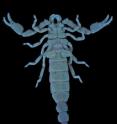Phylogenetic analysis of Mexican cave scorpions suggests adaptation to caves is reversable
Blind scorpions that live in the stygian depths of caves are throwing light on a long-held assumption that specialized adaptations are irreversible evolutionary dead-ends. According to a new phylogenetic analysis of the family Typhlochactidae, scorpions currently living closer to the surface (under stones and in leaf litter) evolved independently on more than one occasion from ancestors adapted to life further below the surface (in caves). The research, currently available in an early online edition, will be published in the April issue of Cladistics. "Our research shows that the evolution of troglobites, or animals adapted for life in caves, is reversible," says Lorenzo Prendini, Associate Curator in the Division of Invertebrate Zoology at the American Museum of Natural History. "Three more generalized scorpion species living closer to the surface evolved from specialized ancestors living in caves deep below the surface."
Scorpions are predatory, venomous, nocturnal arachnids that are related to spiders, mites, and other arthropods. About 2,000 species are distributed throughout the world, but only 23 species found in ten different families are adapted to a permanent life in caves. These are the specialized troglobites.
This study concentrates on the family Typhlochactidae that includes nine species of scorpions endemic to the karstic regions of eastern Mexico. These species were initially grouped together by Robert Mitchell in 1971 but were elevated to the rank of family for the first time last year, based on morphological data published by Prendini and Valerio Vignoli of the Department of Evolutionary Biology, University of Siena, Italy, in the Bulletin of the American Museum of Natural History. Prendini, Vignoli, and Oscar F. Francke of the Departmento de Zoologia, Instituto de Biología at the Universidad Nacional Autónoma de México, Mexico City, also created a new genus, Stygochactas, for one species in the family and described a new surface-living species, Typhlochactas sissomi, in a separate American Museum Novitates paper. All species in the family have adapted to the dark with features such as loss of eyes and reduced pigmentation. The family contains the most specialized troglobite scorpion, Sotanochactas elliotti, one of the world's smallest scorpions, Typhlochactas mitchelli, and the scorpion found at the greatest depth (nearly 1 km below the surface), Alacran tartarus. Three of the species (including T. mitchelli) live closer to the surface and are more generalized morphologically than the other six, making this family an excellent model with which to test and falsify Cope's Law of the unspecialized (novel evolutionary traits tend to originate from a generalized member of an ancestral taxon) and Dollo's Law of evolutionary irreversibility (specialized evolutionary traits are unlikely to reverse).
For the current research paper, Prendini and colleagues gathered data for 195 morphological characteristics, including a detailed mapping of the positions of all trichobothria (sensory setae) on the pedipalps, among the species of Typhlochactidae. The resulting phylogenetic tree shows that adaptation to life in caves has reversed among this group of scorpions: two of the less specialized, surface-living species, T. mitchelli and T. sylvestris, share a common ancestor with a much more cave-adapted species, and a similar pattern was found for the third less specialized, surface-living species, T. sissomi.
"Scorpions have been around for 450 million years, and their biology is obviously flexible," says Prendini. "This unique group of eyeless Mexican scorpions may have started re-colonizing niches closer to the surface from the deep caves of Mexico after their surface-living ancestors were wiped out by the nearby Chicxuluxb impact along with non-avian dinosaurs, ammonites, and other species."
Source: American Museum of Natural History
Other sources
- Phylogenetic analysis of Mexican cave scorpions suggests adaptation to caves is reversablefrom Biology News NetSat, 13 Mar 2010, 4:42:17 UTC
- Phylogenetic analysis of Mexican cave scorpions suggests adaptation to caves is reversablefrom Science BlogFri, 12 Mar 2010, 16:21:26 UTC
- Phylogenetic analysis of Mexican cave scorpions suggests adaptation to caves is reversablefrom PhysorgFri, 12 Mar 2010, 16:07:38 UTC
